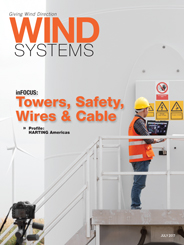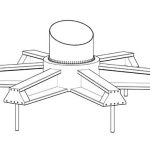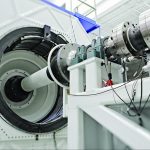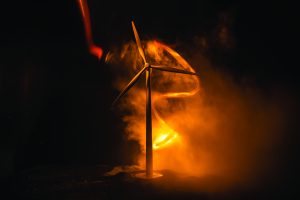Each year at the AWEA WINDPOWER expo, there seems to be a buzz within each sector of the wind industry’s supply chain.
This year was no different. Within the wire-and-cable industry, everyone is talking about continued cost reductions in the supply chain. Two cost areas in particular are the overall cost of the supply chain itself and the other is the use of aluminum conductors.
Let’s address the supply chain partner reduction concept first:
For this article, the supply of cable accessories such as plastic/metal glands and fittings as being associated with the cable manufacturer will be included. In general terms, a turbine manufacturer has, on average, four to six approved cable/accessory suppliers.
Each supplier has its own account management costs within the turbine company, and exact costs vary between turbine manufacturers. Let’s assume each purchase order issued to a supplier has a total internal processing cost of $60. If a company processes 30 purchase orders per month at an average cost of $60 for all six suppliers, the turbine company has $10,800 per month in just purchase order processing costs (6 suppliers x 30 POs = 180 POs x $60/PO).
If strategic supply chain partnerships are formed with a cable manufacturer that not only has a history of supplying quality cable but can also supply accessories, terminated assemblies, and kitted items, a reduction in operating costs is not unrealistic. How much of a supply chain cost savings the turbine manufacturer will see on its bottom line depends on how many individual procurement functions can be eliminated by reducing the number of supply chain partners.

The second area overheard during discussions this year was replacing copper with aluminum conductors in the cabling in the down-tower segment of the turbine.
From a cost perspective, aluminum historically has been significantly cheaper than the standard copper conductor used for wind cables. Copper is approximately two times more expensive than aluminum. The greater availability of raw aluminum compared to copper accounts for this significant difference in price. After oxygen and silicon, aluminum is the third most common element in the Earth’s upper crust, while copper is ranked 25th in availability on the list of raw materials. Assessment of current prices is further reinforced by the volatility of the raw materials market.
Looking at the numbers from only the last 18 months, copper prices fluctuated within a range from $2.28 to $3.08 a pound. The price of aluminum does not fluctuate as volatilely as copper, which allows purchasing departments to make better estimates during the material-planning phase.
From a mechanical and handling perspective, the introduction of flexible aluminum stranding has displaced the notion that aluminum cabling is stiff, hard to handle, and hard to install. Switching to aluminum successfully is a matter of understanding the capabilities of this conductive metal and how to deal with the challenges it presents.
Physical and Electrical Properties
If aluminum is used as a conductor material, its lower conductivity requires a wire size approximately one-third larger than that of a copper wire with the same desired conductivity requirements. In the end, however, the insulating material used with the wire plays a crucial role in performance, and an aluminum wire can possess the same current-carrying capacity as a H07RN-F copper wire. Aluminum’s larger wire size would only be a disadvantage in applications requiring tight spacing, such as in densely packed control boxes.
The facts for aluminum speak for themselves when it comes to the issue of weight. As a raw material, aluminum is approximately 70 percent lighter compared to the same amount of copper. This can be helpful in the efforts of numerous application fields looking to reduce the weight of all components. Naturally, when used in electrical cables, the lower weight makes them easier to install in less time. High-voltage lines have long been made from aluminum; the lighter weight reduces the tensile force placed on the wire and masts significantly. But even industries such as automotive manufacturing and the aeronautical industry are switching to aluminum wires. This is why entire wiring harnesses made of aluminum already are installed in the Airbus A380. Aluminum wires can be up to 60 percent lighter than comparable current-carrying copper wires.
Oxidation in the Air
When exposed to oxygen, a hard and resistant oxide coating forms within a short period of time on the surface of aluminum. The coating protects the subjacent material from further corrosion. This effect makes aluminum a highly durable material. However, the protective oxide coating on the material surface is not desirable when it comes to electrical engineering. It degrades the conductivity of the aluminum and makes contacting difficult. If an oxidized conductor is connected without any pre-treatment (to remove the coating), the contact resistance will increase between the aluminum conductor and the connector component. This can result in temperature increases and, under worst-case conditions, cable fires.

To prevent such problems, the oxide coating must be broken or removed physically. This is done by brushing the bare aluminum conductor ends before contacts are made and also during any termination process. Connector components for aluminum conductors are equipped with a special contact grease from the factory, usually a grainy, abrasive material such as corundum. Combined with high pressure, the corundum particles cause an abrasive effect that breaks the non-conductive oxide coating on the aluminum, improving contact properties and electrical connections. The grease also prevents moisture and oxygen from entering and causing any new corrosion of the contact points. Better quality cable lugs are generally equipped with plastic plugs, which prevent the contact grease from drying out or leaking during storage.
Electrochemical Precious Metals
When it comes to specifying electrical connection components, the corrosive reactions of aluminum in the presence of other metals — mainly copper — also must be considered.
When aluminum comes into contact with more noble metals (metals with higher electro-potential) such as copper, iron, or brass, an electrochemical reaction may occur by means of contact element formation. This reaction is activated by conductive liquids. This manifests in the field mostly as condensed water (condensation). In this process, the potential differences produced by the electrochemical voltage series play a crucial role. The copper electrode (anode), electrolyte (water), and the aluminum electrode (cathode) create a contact element. Any voltage across these elements is short-circuited by the contact between the copper and aluminum. The resulting current creates a decomposition process in the aluminum, which is visible as a radiant oxidation point revealing the contamination of tiny copper particles. However, the copper does not decompose. But the decomposition process negatively affects the electrical connection over the long term, with increasing contact resistances that lead to temperature increases and even to fires.
Therefore, using an aluminum/copper (Al/Cu) cable lug is recommended for connecting aluminum to copper peripherals. Bimetal connectors such as Al/Cu cable lugs, press connectors, and connecting bolt pins are manufactured using a friction-welding process. They are encapsulated to prevent liquids from penetrating the connection and causing any unwanted creepage. The use of Al/Cu connectors and connections is the most sensible way of combating the effects of oxidation on aluminum.
Another means of protecting against moisture is installing a secondary insulation on the contact area. Depending on the field of application, mechanical load, and environmental conditions, a cold-roll or a heat-shrink tube can be used. The best protection results are achieved by heat-shrink tubes with an inside adhesive. At the same time, the electrical contacts should be inspected thoroughly during regularly scheduled maintenance.
In summary, aluminum cables can be a successful alternative to copper cables — in terms of performance and pricing — when the proper engineering techniques are used at both the manufacturing and end-user levels of the supply chain.





































